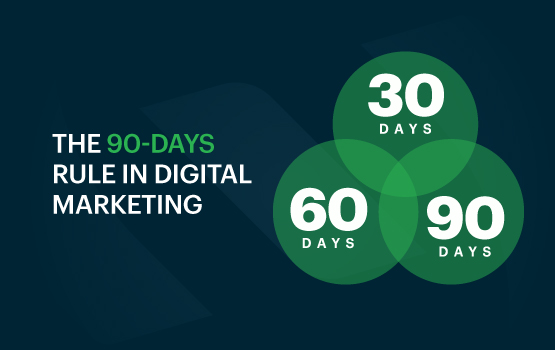Timing and right strategy are keys to succeeding in digital marketing, more than ever before.
Want to fulfill your goals smartly? Implement the 90-day rule and achieve the desired outcome.
You can prioritize your efforts and remain on track towards achieving objectives effortlessly if you set up clear goals and timeframes.
If your business isn’t where you want it to be, now is the time to make changes.
Understanding the 90-Day Rule in Digital Marketing
The 90-Day Rule serves as a pivotal benchmark for decision-making based on data-driven insights.
It provides a comprehensive view of the effectiveness of marketing strategies and allows for iterative optimization.
He rule recognizes that meaningful insights often emerge over time, necessitating a sufficient data collection period. By adhering to the 90-day timeframe, marketers can make informed decisions, allocate budget effectively, and maximize the return on investment in their digital marketing activities.
Let’s understand its significance in digital marketing.
Importance of the 90-Day Framework
The strategy you create must be carried out for at least 90 days if you want fruitful results in digital marketing.
This will allow you enough time to settle into a rhythm and develop approaches that will engage and interest your audience.
Let’s understand why:
-
The Data Gathering Lifecycle
The 90-day timeline in place is premised on monitoring statistics from the data lifecycle.
Data generation-to-consumption phases provide every single stage of the data journey with tools for smart decision-making, offer optimization opportunities for the future, and eventually influence a marketing campaign development.
Through the lens of the 90-days strategic cycle, marketers can learn how to utilize data collection, analysis, and application without boundaries, leveraging technology to propel their campaigns for even greater results.
-
Budget Allocation and Analysis
It’s not just about having a good return on investment (ROI) once. It’s about having consistent ROI over time. If your ROI remains steady for 90 days, it’s a strong signal that your campaign is working well.
This stability allows you to confidently make decisions about expanding your campaign in the next quarter.
Optimal budget allocation is crucial for achieving a strong ROI in digital marketing. Evaluating the entire campaign’s performance over 90 days helps you make smart decisions about reallocating your budget.
By analyzing data in detail, you can identify which ad sets perform best, allocate more resources to successful campaigns, and redistribute funds from underperforming ones.
This approach ensures that your marketing budget is used wisely, leading to better results.
-
Optimization and Learning
Effective ads aren’t just made by chance. They dynamize by testing, learning and repeating the same process.
The first 90 days of a campaign isn’t when you’re only displaying ads. It’s where you start the discovery of your customers’ behavior. The testing gives you the opportunity to get the details of audience preferences, to test the success of the different ad creatives, and to discover the most relevant targeting options.
With actual data you can easily manage and adjust the plan, modify the action plan as you get more progress and subsequently increase the effectiveness of your campaigns.
-
Maximizing Efficiency For Ultimate Results
The 90-day rule is meant to produce results with the least wasted resources. Adopting this strategy, marketers can get the best out of their marketing campaigns, allocate resources optimally and also promote sustainable growth.
Why Do Tech Giants Delete Data After 90 Days?
Facebook Meta Ads policy implements a 90-day framework for lead data availability due to security and storage considerations. This timeframe ensures data integrity and aligns with most use cases.
Additionally, retaining leads beyond 90 days wouldn’t be beneficial as customer interest typically diminishes. It’s crucial to understand this timeframe to prevent loss of access to valuable leads data and optimize campaign performance.
Even Yahoo Inc. recently announced a change in its data retention policy, shortening the time it keeps user data from 13 months to just 90 days. This move comes amid concerns from regulators about online privacy.
The shorter retention period could put pressure on competitors like Google Inc. and Microsoft Corp. to also reduce the time they keep user information. For example, Google started removing some personal data after nine months, while Microsoft, which currently holds data for 18 months, has agreed to support a standard of six months.
Wrapping It Up
The 3-month rule or 90 days window emerges as a pillar of marketing strategy amid the fuss of competing strategies and trends, acting as a compass for the marketer decoding the complexities of digital marketing.
Through the understanding of the power of this timeline, creativity becomes a priority. Therefore, take the 90 days into account every time you set digital marketing initiatives and see for yourself the effectiveness of this approach.
90-Days Marketing Rule FAQs
-
What is the 90 day rule in marketing?
The 90-day marketing rule is a strategic guideline where marketers use the three-month period to measure the effectiveness of their campaigns and to make data-based decisions. Marketing professionals believe that following the 70/20/10 rule enables them to get the most out of their marketing campaigns and fulfill their business objectives.
-
What is a 90 day go to market strategy?
A go-to-market strategy for 90 days is a structured plan developed to hit the market in only 90 days. Whether the objective is to quickly introduce the product or service to their targeted audience, generate awareness among this audience, or to sell the product within a reasonably short time frame, it can help.
-
What are the 90 day rule goals?
The goals of the 90-day rule in marketing vary depending on the specific objectives of the campaign or strategy. However, common goals include:
- Analyzing campaign performance: Evaluate the efficiency of marketing campaigns and efforts for 3 months.
- Optimizing strategies: Use data insights gathered during the 90 days to refine targeting, messaging, and creative elements to improve campaign performance.
- Maximizing ROI: Prioritize expenses accurately on an informed budget criteria to maximize investment returns.
- Driving growth: Implement strategies aimed at increasing market share, expanding customer base, and achieving business growth objectives within the 90-day timeframe.
-
What is the 90 day rule for success?
The 90-day rule of success is an idea which suggests that people measure progress in terms of what they accomplish within the next 90 days. By breaking down larger objectives into manageable chunks and focusing on achieving results within a defined timeframe, individuals and businesses can maintain momentum, track progress, and adapt strategies as needed.




